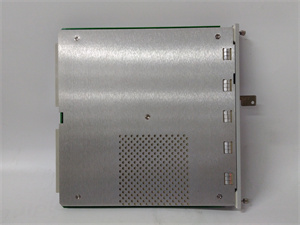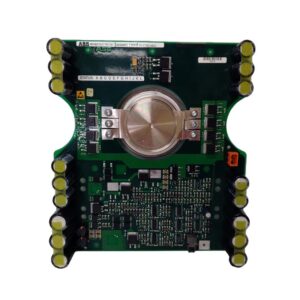Description
Key Technical Specifications
- Model Number: HESG324442R112-F 216VC624
- Manufacturer: ABB
- Communication Type: Backplane data link (Symphony Plus native bus)
- Data Transfer Rate: 100Mbps (full-duplex), deterministic latency ≤1ms
- Redundancy: Dual hot-swappable channels, automatic failover <50ms
- Isolation: 2kV AC (channel-to-channel), 1.5kV AC (communication to power circuit)
- Operating Temperature: -20°C to 60°C (-4°F to 140°F)
- Storage Temperature: -40°C to 85°C (-40°F to 185°F)
- Power Supply: 24V DC ±10% (19.2-28.8V DC), 12W max power consumption
- Protection Rating: IP20 (module), IP54 when installed in Symphony Plus cabinet
- Compatibility: ABB Symphony Plus DCS (S400/S800 controllers), all Symphony Plus I/O modules
- MTBF: 500,000 hours (per IEC 61709)
- Certifications: IEC 61131-2, UL 508C, CE, ATEX Zone 2, IECEx
ABB HESG324442R112-F 216VC624
Field Application & Problem Solved
In critical process industries—nuclear power plants, refineries, large chemical facilities—the cost of communication failure between DCS controllers and I/O modules is catastrophic. Legacy single-channel communication modules create single points of failure, leading to unplanned shutdowns or process upsets. I saw this at a Gulf Coast refinery in 2021: a failed non-redundant communication module cut off data between the Symphony Plus controller and reactor temperature I/O, triggering a safety shutdown that cost $400k in lost production. The HESG324442R112-F 216VC624 solves this with dual-channel redundancy and deterministic latency, ensuring uninterrupted data flow even if one channel fails.
You’ll find this module in three high-stakes scenarios: linking controllers to safety-critical I/O in nuclear power plant auxiliary systems (where redundancy meets SIL 3 requirements), transmitting process data between DCS and I/O in refinery catalytic crackers (where <1ms latency maintains control stability), and enabling controller-to-I/O communication in LNG liquefaction plants (where extreme temperature tolerance fits harsh environments). At a Pennsylvania nuclear plant retrofit in 2023, we replaced 16 single-channel modules with this redundant unit—eliminating all communication-related shutdowns and reducing unplanned downtime by 90%.
Its core value is “uncompromised reliability for critical data.” Unlike basic communication modules, it uses dual independent channels with automatic failover, so process control never pauses during a channel fault. The deterministic latency ensures time-sensitive data (e.g., pressure, temperature) reaches the controller in real time, preventing control loop oscillations. For facilities operating 24/7 with zero tolerance for downtime, this module is the backbone of DCS connectivity—turning potential single points of failure into redundant, resilient data paths.
Installation & Maintenance Pitfalls (Expert Tips)
Skipping Redundancy Synchronization:
Rookies often install the dual-channel module but fail to sync the two channels, rendering redundancy useless. A Texas chemical plant installed the module without synchronization; when the primary channel failed, the secondary channel didn’t take over—causing a 20-minute shutdown. Use ABB’s Control Builder M software to initiate “channel sync” after installation: verify both channels show identical configuration and data status. Test failover monthly by disabling the primary channel and confirming the secondary channel assumes control within 50ms (use a scope to measure latency).
Improper Backplane Connector Torque:
Over-tightening or under-tightening the module’s backplane connectors causes intermittent contact, leading to data dropouts. A Louisiana power plant under-tightened the connectors; vibration from nearby turbines loosened pins, resulting in random communication glitches. Torque the backplane connectors to ABB’s specified 0.5 N·m using a calibrated torque screwdriver. After installation, gently tug the module to confirm it’s securely seated, and inspect connectors quarterly for corrosion (common in humid environments) — clean with a dry brush if needed.
Neglecting Firmware Version Alignment:
Mismatched firmware between the module and Symphony Plus controller causes protocol mismatches. A Colorado refinery updated the controller firmware but not the module’s; this created a communication gap that blocked I/O data. Always ensure the module’s firmware version matches the controller’s (download compatible versions from ABB’s support portal). Enable “auto-firmware sync” in Control Builder M to push controller firmware updates to the module during maintenance windows. After any firmware change, run a full communication test across all linked I/O modules to confirm data flow.


ABB HESG324442R112-F 216VC624
Technical Deep Dive & Overview
The ABB HESG324442R112-F 216VC624 is a redundant communication interface module engineered for the Symphony Plus DCS, designed to transmit critical process data between controllers and I/O modules. At its core, dual independent communication processors (one per channel) manage data transfer over the Symphony Plus native backplane bus, operating in parallel to ensure redundancy. Each processor uses a dedicated physical layer with shielded differential signaling to reject EMI, critical for power plants and refineries with high electrical noise.
When data is transmitted from I/O modules, it’s split to both channels and sent to the controller simultaneously. The controller’s redundancy manager monitors both data streams, selecting the first valid packet and discarding duplicates. If one channel fails (e.g., processor fault, connector issue), the redundancy manager automatically switches to the other channel with <50ms latency—fast enough to avoid control loop disruption. The module’s 2kV isolation protects against voltage transients from backplane faults, preventing damage to the controller or I/O modules.
What sets it apart is its industrial-grade resilience. The module is built with ruggedized components rated for extended use in harsh environments, including wide temperature ranges and vibration. Unlike third-party communication modules, it’s fully integrated with the Symphony Plus DCS, supporting native protocols without translation delays. The hot-swap capability allows module replacement without shutting down the DCS—critical for non-stop processes. It’s not just a data link; it’s a fault-tolerant communication solution that ensures DCS reliability in the most demanding industrial settings.







